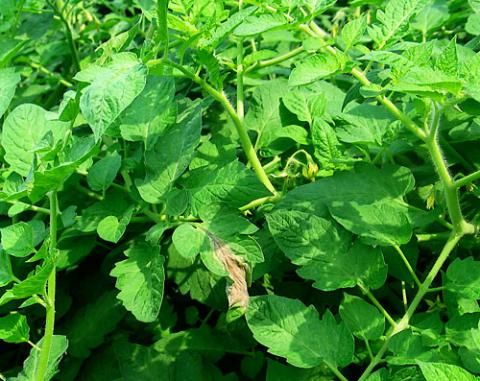
A tomato plant showing the early signs of late blight infection.
Bad news, gardeners: Late blight, which cut a swath of destruction across the Northeast last summer, is back in upstate New York again. Cornell Cooperative Extension sent out a press release yesterday confirming the deadly tomato plague has been found in Norwich, Chenango County. Here's the details:
Late Blight was confirmed on both tomatoes and potatoes on July 27, 2010. Grown in a home garden in the city, the sample was collected on July 25 after the entire crop of tomatoes died almost overnight. Nearby potatoes are also infected.
In an effort to avoid the catastrophe that happened last year, please monitor your tomatoes and potatoes in earnest. Look for dark watery lesions on the leaves, stems and fruit. Late blight spreads quickly. Cornell recommends “If late blight becomes severe, remove diseased plants by digging them up. Destroy these plants immediately by one of the following: burying them deeply in an area away from the garden, burning them, or by bagging them in a plastic bag and discarding the bag. These steps will help avoid production of a larger number of spores. Harvest all potato tubers in the garden. If late blight occurs when the tubers have already 'sized up', harvest the crop as soon as possible to avoid post-harvest tuber rot. Again, destroy diseased foliage and stems.”
There are fungicides that can be sprayed to prevent infection, but once severe infection has taken hold, chemical controls will not work. Commercial growers please checkhttp://www.nysaes.cornell.edu/recommends/ for the latest pesticide recommendations. Home gardeners can follow these recommendations if diagnosis is confirmed: use azoxystrobin (not near apples), Bacillus subtilis, chlorothalonil, copper soap (copper octanoate), or copper sulfate. Protectant fungicides (chlorothalonil or copper products) should be used at first appearance of disease according to the label instructions.
The fungus that causes late blight has become a major threat to home gardens and commercial growers because of the migration of new strains (genotypes) into the United States. Verification of a late blight diagnosis and implementation of prompt control measures are highly recommended. The newly arrived strains are more aggressive than previous strains.
Current information about late blight and its management can be found at http://blogs.cornell.edu/lateblight/ and great webinars on late blight for home organic gardens and organic farms can be found at http://www.extension.org/article/24989. Details on submitting a sample to the Cornell Plant Disease Diagnostic Clinic can be found athttp://plantclinic.cornell.edu/.
Late blight devastated tomato and potato crops in Chenango County and across the Northeast in 2009.
Call 607-334-5841or go to http://www.cce.cornell.edu/chenango for more information.
it's vital to stop the spread of late blight by destroying your plants at the first sign of infection. But when late blight rolls into town, suddenly every spot and droopy leaf on your prize heirloom tomato plant looks like the plague. If you're wondering whether your tomato has the symptoms, check out this helpful illustrated guide from Cornell Cooperative Extension, with a photo gallery of late blight and its most common imitators.










